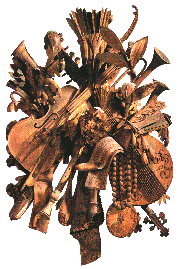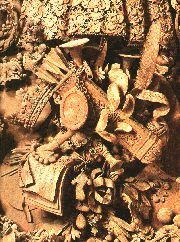
Overmantle, Sudbury Hall
Derbyshire


| TAMWORTH & | S t a f f o r d s h i r e | |
| LICHFIELD COLLEGE | U N I V E R S I T Y | |
| Lichfield Campus |

|
Overmantle, Sudbury Hall Derbyshire |
This paper will mainly cover the great era of woodcarving that started in the 17th century, forward about 150 years and include a reference to a few of the major woodcarvers of that time who became appointed by the king as master woodcarvers. As time goes by, and if anyone wishes to contibute to this page, then I shall add to it as appropriate, and contibuters please get in touch by E-Mail below.
Probably born in 1641, Sculptor to the Crown before Gibbons, succeeding his uncle Henry Phillips, Liveryman of the Joiner's Company in 1666. Work included Kensington Palace, Whitehall, Hampton Court, several London City churches, Chelsea Hospital, and Temple Court.
Born April 4th 1648 of English parents at Rotterdam. His father, James, who was admitted to the freedom of the Drapers' Company in 1638, lived at Rotterdam until 1659.

Grinling Gibbons
The Cosimo panel
Palazzo Pitti, Florence
Gibbons came to England in about 1667 and early on went to York where he was with (but not apprenticed to) John Etty. Finally he left for London and settled with his family at Deptford and did ship carving. He was probably trained in the Quellings' workshop, and the influence of Dutch stil-life and flower painters made a profound impression on him.
He was 'discovered' in January 1671 by John Evelyn. He was appointed Master Carver in Wood to the Crown by Charles II, a position he held until the reign of George Ist. He worked extensively also in stone, as well as wood. He died on August 3rd, 1721 at his house in Bow Street, Covent Garden, and in November of the following year his collection was sold.
Alongside Grinling Gibbons, Edward Pearce, Thomas Young and Roger Davies, was one of the most important woodcarvers of the late 17th Century. He was a liveryman of the Joiners' Company in 1694.
He worked at Castle Howard (1736), and did monuments in Yorkshire with his partners, Harvey and Raper. In 1741 he carved the Gothic pulpit in York Minster made by Leonard Terry to the designs of William Kent. Buried at St Cuthberts, York.
Succeeded to the post of Master Sculptor and Carver in Wood in the Office of Works in 1721 at the death of Grinling Gibbons. Richards was one of the most accomplished carvers of his age. In 1754 he was judged 'infirm' and was succeeded by his assistant, George Murray.
Apprenticed 1746 to Sefferin Alken. Surveyor and repairer of carved work, Windsor Castle, Somerset House, and Greenwich Hospital Chapel.
Assistant to James Richards, and after his master's judged 'infirmity' carried on his master's duties as Master Sculptor and Carver to the Crown. He died in 1761, having formally occupied his Office of Works post for only one year.
Visit us by E-Mail: woodcarving@ldb.co.uk

